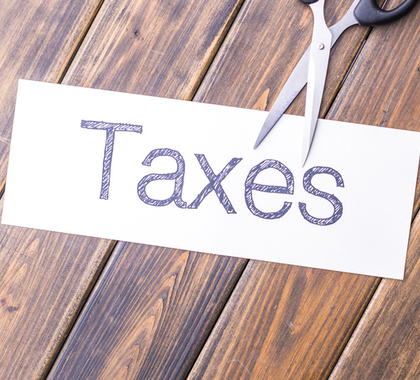Over the past few years, Arizona legislators have considered several proposals to reduce or simplify their personal income tax system. The latest proposal would streamline Arizona’s income tax by implementing a single-rate income tax, collapsing the current system of five tax brackets into one. Some argue the new tax system would not truly be a “flat tax” because the proposal would include tax credits for those in the lowest income bracket.
Arizona’s current tax system has five brackets. The lowest bracket starts at 2.59 percent for individuals with an adjusted gross income of less than $10,000 per year. The current top rate is 4.54 percent for those with an adjusted state income of $150,000 or more. The author of the reform proposal argues the changes are revenue neutral, with the amount of revenue generated by the income tax unchanged from the current system.
Flat taxes are beneficial for several reasons. They avoid penalizing the citizens who produce the majority of jobs and economic activity with higher tax rates. Flat taxes simplify the tax code by eliminating credits, exemptions, and deductions, taxpayers will no longer need to hire expensive tax accountants or use expensive computer programs to file their state taxes. While main critics of flat taxes argue they represent a tax cut for the rich, even under a flat tax, those who earn higher incomes pay more in taxes, achieving the “social justice” progressive tax proponents claim to seek.
Tax revenues are more volatile under progressive tax systems than with flat taxes, making budgeting more difficult. Relying on a small percentage of higher-income taxpayers for a larger percentage of revenues generates revenue windfalls and spending free-for-alls during economic booms, followed by massive budget gaps during economic recessions.
Providing a tax environment that encourages relocation, investment, and economic growth is essential to keep Arizona competitive with its neighboring states. Arizona ranked 21st in the Tax Foundation’s 2016 State Business Tax Climate Index, a study that compares states across multiple areas of taxation that impact business. While this ranking is middle of the state rankings, it is worse than many of Arizona’s neighboring states, including Nevada, which was ranked fifth, Utah (ninth), Texas (14th), and Colorado (16th).
Sound tax reform should adhere to four basic principles, argues John Nothdurft of The Heartland Institute: Taxes should be applied to a broad base, kept at a competitive and low rate, be open and transparent to taxpayers, and not distort the economic choices of consumers and businesses.
Arizona should continue to consider tax reforms that would lower rates, put dollars back into the pockets of taxpayers, and tighten states’ budgets by creating new, reasonable limits on spending. Eliminating income taxes altogether should be every state’s ultimate goal, as no tax is more disruptive to economic growth. While Arizona’s quasi-flat tax could be improved by looking at less-distortionary approaches than to targeted tax credits. Ultimately, this is a clear step toward simplifying the state’s tax code and keeping the state competitive with its neighbors.
The following documents examine the flat tax and income taxes in greater detail.
A Brief Guide to the Flat Tax
https://heartland.org/publications-resources/publications/a-brief-guide-to-the-flat-tax-1?source=policybot
Everything you wanted to know about the flat tax is provided in this PolicyFax by Dan Mitchell of The Heritage Foundation. Mitchell says the flat tax eliminates special-interest favoritism and prevents taxpayers from finding tax loopholes by hiring an army of lawyers, accountants, and lobbyists.
Ten Principles of State Fiscal Policy
https://heartland.org/publications-resources/publications/ten-principles-of-state-fiscal-policy?source=policybot
The Heartland Institute provides policymakers and civic and business leaders a highly condensed, easy-to-read guide to state fiscal policy principles. The principles range from “Above all else: Keep taxes low” to “Protect state employees from politics.”
What Are Flat Taxes?
http://taxfoundation.org/blog/what-are-flat-taxes
Kyle Pomerleau of the Tax Foundation examines flat taxes and explains how different flat tax proposals work.
State Individual Income Tax Rates and Brackets for 2016
http://taxfoundation.org/article/state-individual-income-tax-rates-and-brackets-2016
Nicole Kaeding of the Tax Foundation analyzes the most up-to-date data available on state individual income tax rates, brackets, standard deductions, and personal exemptions for both single and joint filers.
Rich States, Poor States
http://www.alec.org/publications/rich-states-poor-states/
The eighth edition of this publication from the American Legislative Exchange Council and authors Arthur Laffer, Stephen Moore, and Jonathan Williams offers both individual-state and comparative accounts of the negative effects of income taxes.
The Effect of Progressive Tax Codes
https://heartland.org/publications-resources/publications/the-effect-of-progressive-tax-codes?source=policybot
Bill Ahern of the Tax Foundation discusses the effects of different kinds of progressive taxes on taxpayers and the economy.
State Budget Reform Toolkit
https://heartland.org/publications-resources/publications/state-budget-reform-toolkit?source=policybot
The American Legislative Exchange Council outlines a set of budget and procurement best practices to guide state policymakers as they work to solve the budget shortfalls. The toolkit will assist legislators in prioritizing and more efficiently delivering core government services by advancing free markets, limiting government, and promoting federalism and individual liberty.
The Historical Lessons of Lower Tax Rates
http://www.heritage.org/research/reports/2003/08/the-historical-lessons-of-lower-tax-rates
Examining the historical results of income tax cuts, Daniel Mitchell of the Heritage Foundation finds a distinct pattern throughout American history: When tax rates are reduced, the economy’s growth rate improves and living standards increase.
Nothing in this Research & Commentary is intended to influence the passage of legislation, and it does not necessarily represent the views of The Heartland Institute. For further information on this and other topics, visit the Budget & Tax News website, The Heartland Institute’s website, and PolicyBot, Heartland’s free online research database.
The Heartland Institute can send an expert to your state to testify or brief your caucus; host an event in your state, or send you further information on a topic. Please don’t hesitate to contact us if we can be of assistance! If you have any questions or comments, contact John Nothdurft, Heartland’s director of government relations, at [email protected] or 312/377-4000.




